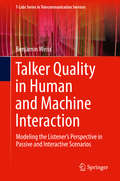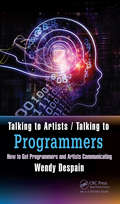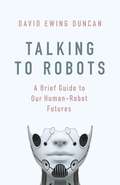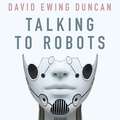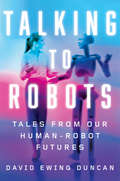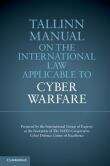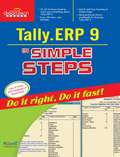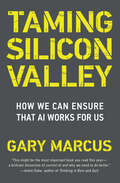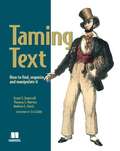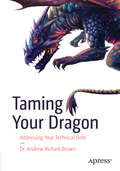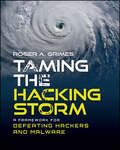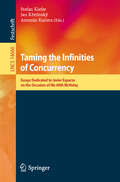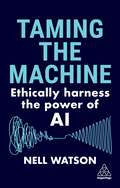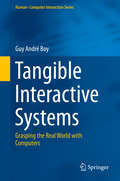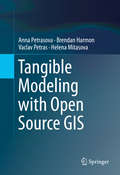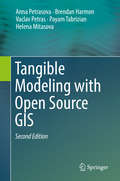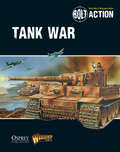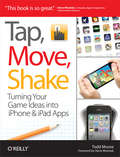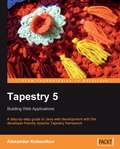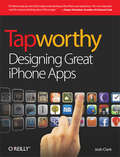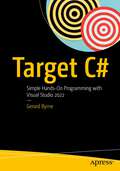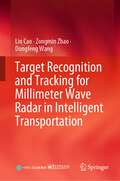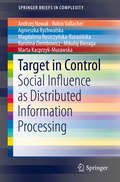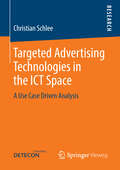- Table View
- List View
Talker Quality in Human and Machine Interaction: Modeling the Listener’s Perspective in Passive and Interactive Scenarios (T-Labs Series in Telecommunication Services)
by Benjamin WeissThe book discusses subjective ratings of quality and preference of unknown voices and dialog partners – their likability, for example. Human natural and artificial voices are studied in passive listening and interactive scenarios. In this book, the background, state of research, and contributions to the assessment and prediction of talker quality that is constituted in voice perception and in dialog are presented. Starting from theories and empirical findings from human interaction, major results and approaches are transferred to the domain of human-computer interaction (HCI). The main objective of this book is to contribute to the evaluation of spoken interaction in humans and between humans and computers, and in particular to the quality subsequently attributed to the speaking system or person based on the listening and interactive experience.Provides a comprehensive overview of research in evaluation of speakers and dialog partners;Presents recent results on the relevance of a first passive and interactive impression;Includes human and HCI evaluation results from a communicative perspective.
Talking to Artists / Talking to Programmers: How to Get Programmers and Artists Communicating
by Wendy DespainArtists and programmers often work together on complex projects in stressful environments and things don’t always go smoothly. Miscommunication and misunderstandings are common as these two disciplines often use the same words to mean different things when they talk to each other. Unintentional slights can turn into long-held grudges and productivity grinds to a crawl. This is a "flip book" that contains two narratives in one. Turn the book one way and read one perspective; turn the book over and upside down and read the other perspective. The narratives can be read separately, one after the other, or in alternating chapters. Talking to Artists / Talking to Programmers can help anyone who wants to improve communication with artists and programmers. It’s set up like a foreign language dictionary, so it addresses the cultural norms, attitudes and customs surrounding the words each group uses, so you’ll know not just what the words in the glossary mean, you’ll know why they’re used that way and how to get communication flowing again. It addresses common reasons for communication problems between these two groups and provides specific suggestions for solutions. The unusual format allows for each side to be given equal weight - learn how to talk to artists starting on one side of the book, turn it over and learn how to talk to programmers. The whole book stresses the things artists and programmers have in common. Focused primarily on videogame developers, it also applies to other fields where tech and art have to work together, including web developers and teams building mobile apps. Anyone who wants to communicate better with programmers or artists - this book can help Features Lists of common problems and strategies for solving them Specific ideas for building bridges between departments Case studies from real teams Glossary of terms causing the most confusion Explanations for common friction points Approaches for fostering goodwill Solutions for team dynamics problems Specific suggestions for providing feedback Ideas for holding successful meetings
Talking to Robots: A Brief Guide to Our Human-Robot Futures
by David Ewing DuncanOne of Time magazine's '32 Books You Need to Read This Summer' -- 'a riveting read'.'Intensely readable, downright terrifying, and surprisingly uplifting.'Vanity Fair'A fascinating work of imaginative futurology, a science journalist takes a look at our current technologies and anticipates the human-robot future that could await us - one full of warrior bots, politician bots, doctor bots and sex bots.'One of Barbara VanDenburgh's '5 Books Not to Miss', USA TodayOne of the best summer reads of 2019, according to top authors David Baldacci and Elizabeth Acevedo on USA Today's Today programme. 'A refreshing variation on the will-intelligent-robots-bring-Armageddon genre . . . this colorful mixture of expert futurology and quirky speculation does not disappoint' Kirkus ReviewsWhat robot and AI systems are being built and imagined right now? What do they say about us, their creators? Will they usher in a fantastic new future, or destroy us? What do some of our greatest thinkers, from physicist Brian Greene and futurist Kevin Kelly to inventor Dean Kamen, geneticist George Church and filmmaker Tiffany Shlain, anticipate for our human-robot future? For even as robots and AI intrigue us and make us anxious about the future, our fascination with robots has always been about more than the potential of the technology - it also concerns what robots tell us about being human.From present-day Facebook and Amazon bots to near-future 'intimacy' bots and 'the robot that swiped my job' bots, bestselling American popular science writer David Ewing Duncan's Talking to Robots is a wonderfully entertaining and insightful guide to possible future scenarios about robots, both real and imagined.Featured bots include robot drivers; doc bots; politician bots; warrior bots; sex bots; syntheticbio bots; dystopic bots that are hopefully just bad dreams; and ultimately, God Bot (asdescribed by physicist Brian Greene). These scenarios are informed by discussions with well-known thinkers, engineers, scientists, artists, philosophers and others, who share with us their ideas, hopes and fears about robots. David spoke with, among others, Kevin Kelly, David Baldacci, Brian Greene, Dean Kamen, Craig Venter, Stephanie Mehta, David Eagleman, George Poste, George Church, General R. H. Latiff, Robert Seigel, Emily Morse, David Sinclair, Ken Goldberg, Sunny Bates, Adam Gazzaley, Tim O'Reilly, Tiffany Shlain, Eric Topol and Juan Enriquez.These discussions, along with some reporting on bot-tech, bot-history and real-time societal andethical issues with robots, are the launch pads for unfurling possible bot futures that are informed by how people and societies have handled new technologies in the past.The book describes how robots work, but its primary focus is on what our fixation with botsand AI says about us as humans: about our hopes and anxieties; our myths, stories, beliefs andideas about beings both real and artificial; and our attempts to attain perfection.We are at a pivotal moment when our ancient infatuation with human-like beings with certainattributes or superpowers - in mythology, religion and storytelling - is coinciding with ourability to actually build some of these entities.
Talking to Robots: A Brief Guide to Our Human-Robot Futures
by David Ewing DuncanOne of Time magazine's '32 Books You Need to Read This Summer' -- 'a riveting read'.'Intensely readable, downright terrifying, and surprisingly uplifting.'Vanity Fair 'A fascinating work of imaginative futurology, a science journalist takes a look at our current technologies and anticipates the human-robot future that could await us - one full of warrior bots, politician bots, doctor bots and sex bots.'One of Barbara VanDenburgh's '5 Books Not to Miss', USA Today One of the best summer reads of 2019, according to top authors David Baldacci and Elizabeth Acevedo on USA Today's Today programme. 'A refreshing variation on the will-intelligent-robots-bring-Armageddon genre . . . this colorful mixture of expert futurology and quirky speculation does not disappoint' Kirkus ReviewsWhat robot and AI systems are being built and imagined right now? What do they say about us, their creators? Will they usher in a fantastic new future, or destroy us? What do some of our greatest thinkers, from physicist Brian Greene and futurist Kevin Kelly to inventor Dean Kamen, geneticist George Church and filmmaker Tiffany Shlain, anticipate for our human-robot future? For even as robots and AI intrigue us and make us anxious about the future, our fascination with robots has always been about more than the potential of the technology - it also concerns what robots tell us about being human.From present-day Facebook and Amazon bots to near-future 'intimacy' bots and 'the robot that swiped my job' bots, bestselling American popular science writer David Ewing Duncan's Talking to Robots is a wonderfully entertaining and insightful guide to possible future scenarios about robots, both real and imagined.Featured bots include robot drivers; doc bots; politician bots; warrior bots; sex bots; syntheticbio bots; dystopic bots that are hopefully just bad dreams; and ultimately, God Bot (asdescribed by physicist Brian Greene). These scenarios are informed by discussions with well-known thinkers, engineers, scientists, artists, philosophers and others, who share with us their ideas, hopes and fears about robots. David spoke with, among others, Kevin Kelly, David Baldacci, Brian Greene, Dean Kamen, Craig Venter, Stephanie Mehta, David Eagleman, George Poste, George Church, General R. H. Latiff, Robert Seigel, Emily Morse, David Sinclair, Ken Goldberg, Sunny Bates, Adam Gazzaley, Tim O'Reilly, Tiffany Shlain, Eric Topol and Juan Enriquez.These discussions, along with some reporting on bot-tech, bot-history and real-time societal andethical issues with robots, are the launch pads for unfurling possible bot futures that are informed by how people and societies have handled new technologies in the past.The book describes how robots work, but its primary focus is on what our fixation with botsand AI says about us as humans: about our hopes and anxieties; our myths, stories, beliefs andideas about beings both real and artificial; and our attempts to attain perfection.We are at a pivotal moment when our ancient infatuation with human-like beings with certainattributes or superpowers - in mythology, religion and storytelling - is coinciding with ourability to actually build some of these entities.
Talking to Robots: Tales from Our Human-Robot Futures
by David Ewing DuncanAward-winning journalist David Ewing Duncan considers 24 visions of possible human-robot futures—Incredible scenarios from Teddy Bots to Warrior Bots, and Politician Bots to Sex Bots—Grounded in real technologies and possibilities and inspired by our imagination. What robot and AI systems are being built and imagined right now? What do they say about us, their creators? Will they usher in a fantastic new future, or destroy us? What do some of our greatest thinkers, from physicist Brian Greene and futurist Kevin Kelly to inventor Dean Kamen, geneticist George Church, and filmmaker Tiffany Shlain, anticipate about our human-robot future? For even as robots and A.I. intrigue us and make us anxious about the future, our fascination with robots has always been about more than the potential of the technology–it’s also about what robots tell us about being human.
Tallinn Manual on the International Law Applicable to Cyber Warfare
by Michael N. SchmittThe product of a three-year project by twenty renowned international law scholars and practitioners, the Tallinn Manual identifies the international law applicable to cyber warfare and sets out ninety-five 'black-letter rules' governing such conflicts. It addresses topics including sovereignty, State responsibility, the jus ad bellum, international humanitarian law, and the law of neutrality. An extensive commentary accompanies each rule, which sets forth the rule's basis in treaty and customary law, explains how the group of experts interpreted applicable norms in the cyber context, and outlines any disagreements within the group as to each rule's application.
Tally.ERP 9 in Simple Steps
by Kogent Learning Solutions IncTally.ERP 9 in Simple Steps is a book that helps you to learn Tally quickly and easily. Precise and complete, with an easy to understand style, examples to support the concepts, and use of practical approach in presentation are some of the features that make the book unique in itself. The text in the book is presented in such a way that it will be equally helpful to the beginners as well as to the professionals. Apart from the basic concepts of Tally, this edition of the book deals with some advanced topics, such as VAT, TDS/TCS, Service Tax, Data BackUp and Restore, Emailing from Tally.ERP 9, Migration from Tally 7.2 to Tally 9, Configuring and using Tally.NET in Tally.ERP 9, etc.
Taming Silicon Valley: How We Can Ensure That AI Works for Us
by Gary F. MarcusHow Big Tech is taking advantage of us, how AI is making it worse, and how we can create a thriving, AI-positive world.On balance, will AI help humanity or harm it? AI could revolutionize science, medicine, and technology, and deliver us a world of abundance and better health. Or it could be a disaster, leading to the downfall of democracy, or even our extinction. In Taming Silicon Valley, Gary Marcus, one of the most trusted voices in AI, explains that we still have a choice. And that the decisions we make now about AI will shape our next century. In this short but powerful manifesto, Marcus explains how Big Tech is taking advantage of us, how AI could make things much worse, and, most importantly, what we can do to safeguard our democracy, our society, and our future.Marcus explains the potential—and potential risks—of AI in the clearest possible terms and how Big Tech has effectively captured policymakers. He begins by laying out what is lacking in current AI, what the greatest risks of AI are, and how Big Tech has been playing both the public and the government, before digging into why the US government has thus far been ineffective at reining in Big Tech. He then offers real tools for readers, including eight suggestions for what a coherent AI policy should look like—from data rights to layered AI oversight to meaningful tax reform—and closes with how ordinary citizens can push for what is so desperately needed.Taming Silicon Valley is both a primer on how AI has gotten to its problematic present state and a book of activism in the tradition of Abbie Hoffman&’s Steal This Book and Thomas Paine&’s Common Sense. It is a deeply important book for our perilous historical moment that every concerned citizen must read.
Taming Text: How to Find, Organize, and Manipulate It
by Grant Ingersoll Thomas S. Morton Drew FarrisSummaryTaming Text, winner of the 2013 Jolt Awards for Productivity, is a hands-on, example-driven guide to working with unstructured text in the context of real-world applications. This book explores how to automatically organize text using approaches such as full-text search, proper name recognition, clustering, tagging, information extraction, and summarization. The book guides you through examples illustrating each of these topics, as well as the foundations upon which they are built.About this BookThere is so much text in our lives, we are practically drowningin it. Fortunately, there are innovative tools and techniquesfor managing unstructured information that can throw thesmart developer a much-needed lifeline. You'll find them in thisbook.Taming Text is a practical, example-driven guide to working withtext in real applications. This book introduces you to useful techniques like full-text search, proper name recognition,clustering, tagging, information extraction, and summarization.You'll explore real use cases as you systematically absorb thefoundations upon which they are built.Written in a clear and concise style, this book avoids jargon, explainingthe subject in terms you can understand without a backgroundin statistics or natural language processing. Examples arein Java, but the concepts can be applied in any language.Written for Java developers, the book requires no prior knowledge of GWT. Purchase of the print book comes with an offer of a free PDF, ePub, and Kindle eBook from Manning. Also available is all code from the book. Winner of 2013 Jolt Awards: The Best Books—one of five notable books every serious programmer should read.What's InsideWhen to use text-taming techniquesImportant open-source libraries like Solr and MahoutHow to build text-processing applicationsAbout the AuthorsGrant Ingersoll is an engineer, speaker, and trainer, a Lucenecommitter, and a cofounder of the Mahout machine-learning project. Thomas Morton is the primary developer of OpenNLP and Maximum Entropy. Drew Farris is a technology consultant, software developer, and contributor to Mahout,Lucene, and Solr."Takes the mystery out of verycomplex processes."—From the Foreword by Liz Liddy, Dean, iSchool, Syracuse UniversityTable of ContentsGetting started taming textFoundations of taming textSearchingFuzzy string matchingIdentifying people, places, and thingsClustering textClassification, categorization, and taggingBuilding an example question answering systemUntamed text: exploring the next frontier
Taming Your Dragon: Addressing Your Technical Debt
by Dr. Andrew BrownTechnical debt is an often-overlooked problem that the software industry needs to take more seriously. All organizations are impacted by it, most wish that they had less of it, but need help in understanding the nature of the beast. This book aims to clear up any misconceptions and show you how to implement a sound technical debt management program to suit your company’s needs. You’ll learn the greatest challenge in solving the technical debt dilemma is not to find solutions to it, but rather to find solutions to the human and organizational issues that lead to that debt. For example, convincing senior stakeholders of the importance of addressing technical debt, getting stakeholders to acknowledge how their actions lead to unintentional debt, and enabling teams to prioritize technical debt over short-term goals. Therefore, this book is divided into three parts: defining technical debt, understanding technical debt, and tackling technical debt. It begins by explaining why technical debt should not be considered a technical problem, but rather a problem of how trade-off decisions are made. You’ll then examine how making decisions using the affect heuristic, more commonly known as a “gut feeling,” can lead to unnecessary technical debt, followed by some techniques for combating your vulnerability to this trap. Reducing your organization’s level of technical debt is not easy. Taming Your Dragon will show you how to implement a technical debt management program. What You Will Learn Review a new paradigm based on technical debt being a combination of trade-off problems and system problems Understand the many ways that technical debt adversely affects an organization’s ability to deliver IT change Create an effective process for addressing technical debt See why analogies are important Who This Book Is For Software teams supporting DevOps, managers, and other business stakeholders looking to implement a technical debt management program.
Taming the Hacking Storm: A Framework for Defeating Hackers and Malware
by Roger A. GrimesA transformative new approach to Internet security from an experienced industry expert Taming the Hacking Storm: A Framework for Defeating Hackers and Malware is a groundbreaking new roadmap to solving the ubiquitous Internet security issues currently plaguing countries, businesses, and individuals around the world. In easy-to-understand and non-technical language, author and cybersecurity veteran Roger Grimes describes the most prevalent threats to our online safety today and what ties them all together. He goes on to lay out a comprehensive and robust framework for combating that threat—one that rests on a foundation of identity verification—and explains exactly how to implement it in the real world. The author addresses each of the challenges, pitfalls, and roadblocks that might stand in the way of his solutions, offering practical ways to navigate, avoid, or counter those impediments. The book also includes: How to address peripheral security issues, including software and firmware vulnerabilities Strategies for addressing a lack of international agreement on the implementation of security standards and practices Things you can do today to encourage the development of a more secure, trusted Internet An insightful and original new approach to cybersecurity that promises to transform the way we all use the Internet, Taming the Hacking Storm is a must-read guide for cybersecurity practitioners, academic researchers studying Internet security, and members of the general public with an interest in tech, security, and privacy.
Taming the Infinities of Concurrency: Essays Dedicated to Javier Esparza on the Occasion of His 60th Birthday (Lecture Notes in Computer Science #14660)
by Stefan Kiefer Jan Křetínský Antonín KučeraJavier Esparza received his primary degree in Theoretical Physics and in 1990 his PhD in Computer Science from the University of Zaragoza. After positions at the University of Hildesheim, the University of Edinburgh, and the Technical University of Munich, he then held professorships at the University of Edinburgh and the University of Stuttgart, and finally returned to TU Munich where he currently holds the Chair of Foundations of Software Reliability and Theoretical Computer Science. Javier is a leading researcher in concurrency theory, distributed and probabilistic systems, Petri nets, analysis of infinite-state models, and more generally formal methods for the verification of computer systems. He has coauthored over 200 publications, many of them highly influential. He coauthored the monographs Free Choice Petri Nets, and Unfoldings: A Partial Order Approach to Model Checking, and more recently the textbook Automata Theory: An Algorithmic Approach. The latter is an exampleof Javier’s many activities as a teacher, he has supervised more than 20 PhD students, taught at more than 20 summer schools, and won many awards for his university teaching. He is regularly invited to deliver plenary talks at prestigious computer science conferences and participate in senior program committees, he has contributed as a senior member of technical working groups, society councils, and journal editorial boards, and in 2021 he became a founding Editor-in-Chief of the open-access TheoretiCS journal. This Festschrift celebrates Javier’s contributions on the occasion of his 60th birthday, the contributions reflect the breadth and depth of his successes in Petri nets, concurrency in general, distributed and probabilistic systems, games, formal languages, logic, program analysis, verification, and synthesis.
Taming the Machine: Ethically Harness the Power of AI
by Nell WatsonAI promises to transform our world, supercharging productivity and driving new innovations. Taming the Machine uncovers how you can responsibly harness the power of AI with confidence.AI has the potential to become a personal assistant, a creative partner, an editor and a research tool all at once. But it also represents a threat to your livelihood, data and privacy. Taming the Machine offers the practical insights and knowledge you need to work with AI with an ethical and responsible approach.In this book, celebrated AI expert and ethicist Nell Watson offers practical insights on how you can ethically innovate with AI. It delves into the ethical issues of unbridled AI, highlighting the challenges that it will bring to society and business unless we fortify cybersecurity, safeguard our data, and understand the dangerous potential of artificial intelligence.Step into the future and supercharge your performance safely by Taming the Machine.
Tangible Interactive Systems
by Guy André BoyDistinguishingbetween tangible user interfaces (TUI) and tangible interactive systems (TISs),this book takes into account not only the user interfaces but also looks at howinteraction can be enabled by using digital information through the physicalenvironment. TISs go far beyond the concept of tangible user interfaces,addressing large complex systems in the framework of human-centred design andputting the human at the center of the design process from the start. Howcan human-centered designers grasp the real world with computers? This questionis explored by looking at concepts such as innovation, complexity, flexibility,maturity, stability, sustainability and art to see whether we can assess bothphysical and figurative tangibility during the design process before productdelivery. Concepts like creativity, design thinking and team spirit arefundamental to TIS's human-centered design, and are presented together withhuman-systems integration (HSI), agile development and formative evaluations tobuild a greater understanding of this new area of research. TangibleInteractive Systems wouldbe an essential read to designers, academics and other professionals concernedwith product design within HCI, industrial design, virtual engineering andother related areas.
Tangible Modeling with Open Source GIS
by Helena Mitasova Anna Petrasova Brendan Harmon Vaclav PetrasThis book presents a new type of modeling environment where users interact with geospatial simulations using 3D physical models of studied landscapes. Multiple users can alter the physical model by hand during scanning, thereby providing input for simulation of geophysical processes in this setting. The authors have developed innovative techniques and software that couple this hardware with open source GRASS GIS, making the system instantly applicable to a wide range of modeling and design problems. Since no other literature on this topic is available, this Book fills a gap for this new technology that continues to grow. Tangible Modeling with Open Source GIS will appeal to advanced-level students studying geospatial science, computer science and earth science such as landscape architecture and natural resources. It will also benefit researchers and professionals working in geospatial modeling applications, computer graphics, hazard risk management, hydrology, solar energy, coastal and fluvial flooding, fire spread, landscape, park design and computer games.
Tangible Modeling with Open Source GIS
by Helena Mitasova Anna Petrasova Brendan Harmon Vaclav Petras Payam TabrizianThis book provides an overview of the latest developments in the fast growing field of tangible user interfaces. It presents a new type of modeling environment where the users interact with geospatial data and simulations using 3D physical landscape model coupled with 3D rendering engine. Multiple users can modify the physical model, while it is being scanned, providing input for geospatial analysis and simulations. The results are then visualized by projecting images or animations back on the physical model while photorealistic renderings of human views are displayed on a computer screen or in a virtual reality headset. New techniques and software which couple the hardware set-up with open source GRASS GIS and Blender rendering engine, make the system instantly applicable to a wide range of applications in geoscience education, landscape design, computer games, stakeholder engagement, and many others. This second edition introduces a new more powerful version of the tangible modeling environment with multiple types of interaction, including polymeric sand molding, placement of markers, and delineation of areas using colored felt patches. Chapters on coupling tangible interaction with 3D rendering engine and immersive virtual environment, and a case study integrating the tools presented throughout this book, demonstrate the second generation of the system - Immersive Tangible Landscape - that enhances the modeling and design process through interactive rendering of modeled landscape. This book explains main components of Immersive Tangible Landscape System, and provides the basic workflows for running the applications. The fundamentals of the system are followed by series of example applications in geomorphometry, hydrology, coastal and fluvial flooding, fire spread, landscape and park design, solar energy, trail planning, and others. Graduate and undergraduate students and educators in geospatial science, earth science, landscape architecture, computer graphics and games, natural resources and many others disciplines, will find this book useful as a reference or secondary textbook. Researchers who want to build and further develop the system will most likely be the core audience, but also anybody interested in geospatial modeling applications (hazard risk management, hydrology, solar energy, coastal and fluvial flooding, fire spread, landscape and park design) will want to purchase this book.
Tank War
by Warlord GamesTank War, the new supplement for Bolt Action, gives players the option to expand their games to a whole new level - armored warfare. Recreate such great engagements as the battle of Kursk with the scenarios, army options and special rules found in this book. Whether you want to add more armour to your existing armies or build an entirely armoured force, Tank War has you covered.
Tap, Move, Shake: Turning Your Game Ideas into iPhone & iPad Apps
by Todd MooreGot a great game idea? This complete do-it-yourself guide shows you how to make your game idea a reality for the iPhone and iPad. By developing a real game hands-on through the course of this book, you'll get a thorough introduction to Xcode and Objective-C, while learning how to implement game logic, sophisticated graphics, game physics, sounds, and computer AI. Author Todd Moore taught himself how to create an iPhone game in a week, with no previous knowledge of Apple's development tools. Now he develops smartphone games and apps full time. With this book, any coder can turn game ideas into real products, ready for the App Store. Get started by writing a simple game in only 20 lines of code Build a complete air hockey game from scratch Learn best practices for tracking multiple screen touches Use animation loops and create collision functions Get the tools you need to build your own stunning game graphics Apply game physics to give your game a sense of realism Record and edit lifelike sound effects, and create your own background music Design a computer player with different levels of difficulty Featuring an introduction by Steve Wozniak Todd Moore founded TMSOFT to create unique smart phone applications and games. His most popular game title, Card Counter, was featured by Engadget, the Los Angeles Times, and CNET TV. Todd's most popular application, White Noise, was featured by iTunes, Health Magazine, The Washington Post, PC Magazine, and Late Night with Jimmy Fallon.
Tapestry 5: Building Web Applications
by Alexander KolesnikovThis book is for those who want to build sophisticated Java web applications quickly and easily. It assumes that the reader is reasonably comfortable with the Java programming language, but no knowledge of web technologies is needed. For experienced Servlet, JSP, or Struts developers, the book will show an alternative way that will allow them to raise their productivity to an incomparable level. With this book you will see that a contemporary component-based framework can be easy to learn and a pleasure to work with.
Tapworthy: Designing Great iPhone Apps
by Josh ClarkSo you've got an idea for an iPhone app -- along with everyone else on the planet. Set your app apart with elegant design, efficient usability, and a healthy dose of personality. This accessible, well-written guide shows you how to design exceptional user experiences for the iPhone and iPod Touch through practical principles and a rich collection of visual examples.Whether you're a designer, programmer, manager, or marketer, Tapworthy teaches you to "think iPhone" and helps you ask the right questions -- and get the right answers -- throughout the design process. You'll explore how considerations of design, psychology, culture, ergonomics, and usability combine to create a tapworthy app. Along the way, you'll get behind-the-scenes insights from the designers of apps like Facebook, USA Today, Twitterrific, and many others.Develop your ideas from initial concept to finished designBuild an effortless user experience that rewards every tapExplore the secrets of designing for touchDiscover how and why people really use iPhone appsLearn to use iPhone controls the Apple wayCreate your own personality-packed visuals
Target C#: Simple Hands-On Programming with Visual Studio 2022
by Gerard ByrneSo, you want to learn C# and Visual Studio 2022, but are a bit intimidated? Don’t be. Programming is within your grasp! Programmers at any level have to fully understand, and more importantly, be able to code the core constructs. It is impossible to use complex programming concepts such as classes before understanding what methods and variables and their data types are. Once there is a foundation built on the basics, then all other topics can fall in line.While it is a forgone conclusion that languages change with the introduction of new features, the core concepts do not. Even large enterprises do not always update to the latest versions of languages and frameworks; their "backbone" applications have been developed to work, regardless. More than ever, enterprises need developers who can master and apply the core programming concepts and then be "up-skilled" with newer language levels and features as they integrate into the company. This book builds from the ground up. You will begin with an introduction to programming, learning the foundational concepts needed to become a C# programmer. You will then put to practice a wide range of programming concepts, including data types, selection, iteration, arrays, methods, classes and objects, serialization, file handling, and string handling. You will learn enough to develop applications that emulate commercial application code. Once you’ve got the foundational concepts, get ready to dive into common programming routines, including linear search, binary search, bubble sort and insertion sort, and use C# to code them. Code example annotations supplement the learning and are designed to enhance learning while also explaining why the code does what it does. This book: Teaches core programming through well-explained and simple-to-follow instructionsReinforces programming skills through the use of coding examples that extend user learningsExplains theoretical programming concepts; applies them practically with code examples Introduces the latest Microsoft C# Integrated Development Environment (Visual Studio 2022)Enlists clear, precise, and easy-to-understand language to assist readers of all levels and experienceUses a mix of "theory" and practical information that is designed to be friendly and engaging Who This Book Is ForBeginners, those refreshing their C# skills, or those moving from another programming language. No skills or previous knowledge is required. Readers will need to download Visual Studio 2022 Community Edition as this is what the book code has been based on, but they could use other Integrated Development Environments.
Target Recognition and Tracking for Millimeter Wave Radar in Intelligent Transportation
by Lin Cao Zongmin Zhao Dongfeng WangThis book starts with the introduction of the radar working system from a mathematical point of view. It shows the composition of transmitted signal and echo signal, and describes the principle of speed measurement and distance measurement for different radar systems. The book focuses on millimeter-wave radar technologies related to echo signal denoising, target identification, clustering, and target tracking and develops a workable plan for the information fusion idea between millimeter-wave radar and machine vision.This book breaks down the systematic processing flow of millimeter-wave radar echo signals one by one from the standpoint of intelligent transportation, concentrating on the introduction of principles and reinforced by a plethora of experimental instances. So that readers from all relevant professions may comprehend millimeter-wave radar's involvement throughout the complete system process.
Target in Control: Social Influence as Distributed Information Processing (SpringerBriefs in Complexity)
by Robin R. Vallacher Agnieszka Rychwalska Magdalena Roszczyńska-Kurasińska Karolina Ziembowicz Marta Kacprzyk-Murawska Andrzej K. Nowak Mikolaj BiesagaThis concise monograph introduces and examines social influence from the perspective of the so-called target, rather than from the source, thus providing for the first time a bidirectional account of this pervasive social phenomenon, further bridging simple micro-level dyadic interaction rules with macro-level properties of the (social) system. This integrative approach allows for advanced models of influence to be developed in both the social and natural sciences (e.g. social animals). In particular, when used to investigate emergent properties of social change, this approach shows that social transitions occur as “bubbles of new” in the “sea of old.” While in the traditional view influence is synonymous with achieving power and control over others, the present approach to social influence puts the emphasis on the target’s motives and strategies. Here, the target may actively seek out influence to help forge opinions and achieve guidance regarding courses of action. In this process, the target observes others, models their thought and behavior, and asks for information and opinions. In this broadened perspective, the processes of social influence enables those being influenced (the targets) to use the knowledge and processing capacity of influence sources to maximize their access to information, minimize their processing effort, while optimizing their own functioning and that of the social system in which they evolve. This short text addresses above all scientists interested in social influence in the fields of psychology, sociology, economy, marketing, and biology. However, also researchers interested in modeling social processes, especially opinion dynamics and social change, such as computer scientists, physicists and applied mathematicians will benefit from the insights provided.
Targeted Advertising Technologies in the ICT Space
by Christian SchleeIn recent years, the field of information and communication technology has started to change dramatically. Carriers are threatened by high revenue losses requiring them to identify new revenue potentials beyond their core business. Targeted advertising can be one of these revenue opportunities. Christian Schlee provides a broad overview of the latest developments and trends in targeted advertising in the ICT space. The author focuses on the technological aspects of targeted advertising, but also covers business and legal aspects. He analyzes the most interesting use cases in the Web, IPTV, the mobile environment, and in converged scenarios and examines important technological key building blocks.
Targeted Cancer Therapy in Biomedical Engineering (Biological and Medical Physics, Biomedical Engineering)
by Rishabha Malviya Sonali SundramThis book highlights the role of Biomedical Engineering (BME) used in diagnosis (e.g., body scanners) and treatment (radiation therapy and minimal access surgery in order to prevent various diseases). In recent years, an important progress has been made in the expansion of biomedical microdevices which has a major role in diagnosis and therapy of cancer. When fighting cancer, efficacy and speed are of the utmost importance. A recently developed microfluidic chip has enabled a breakthrough in testing the efficacy of specialized cancer drugs.Effective cancer-targeting therapies will require both passive and active targeting strategies and a thorough understanding of physiologic barriers to targeted drug delivery. Targeted cancer treatments in development and the new combinatorial approaches show promise for improving targeted anticancer drug delivery and improving treatment outcomes.This book discusses the advancements and innovations in the field of BME that improve the diagnosis and treatment of cancer. This book is focused on bioengineering approaches to improve targeted delivery for cancer therapeutics, which include particles, targeting moieties, and stimuli-responsive drug release mechanisms. This book is a useful resource for students, researchers, and professionals in BME and medicine.
